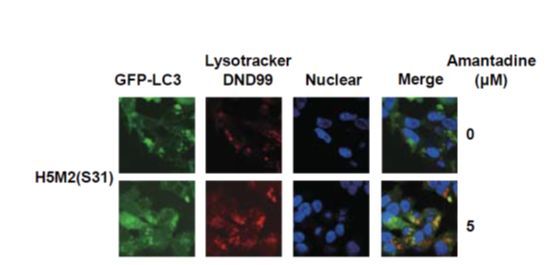Scientists from GIBH discovered that proton channel activity of influenza A virus matrix protein 2 contributes to autophagy arrest
Influenza viruses cause significant morbidity and mortality in humans. An outstanding feature of the virus is its ability to regulate host cellular pathways for its benefit. Recent studies showed that influenza A virus perturbs the autophagy process in infected cells. Autophagy is an intracellular degradation process and is involved in both the sensing of and resistance to viruses invading the host. As a result, the viruses appear to have evolved mechanisms to subvert the autophagy response for their own benefit. Although influenza A virus has been shown to modulate the autophagy process, the underlying mechanisms has remained not well defined.
To observe the effect of influenza A virus on autophagy, Prof Chen Ling and his group used influenza viruses A/Hong Kong/8/68(H3N2) and A/Wisconsin/33(H1N1) to infect HEK293 cells at a multiplicity of infection of 5. They found that both influenza viruses A/Hong Kong/8/68 (H3N2) and A/Wisconsin/33(H1N1) increased the autophagosome marker LC3-Ⅱlevel and induced punctate LC3 perinuclear localization. These results demonstrated that influenza A virus infection can induce autophagosome accumulation.
Prof Chen’s group then used amantadine, an influenza A virus M2 proton channel blocker, and oseltamivir, an influenza A virus neuraminidase inhibitor, to assess if these two antiviral agents have any effect on autophagosome accumulation at the early stage of infection. Surprisingly, amantadine can significantly block autophagosome accumulation in influenza virus A/Hong Kong/8/68(H3N2)-infected cells but not in influenza virus A/Wisconsin/33(H1N1)-infected cells. Oseltamivir showed no effect on autophagosome accumulation in response to both influenza A viruses, indicating that neuraminidase plays no role in autophagosome accumulation. Their findings suggested that the proton channel activity of M2 might play a role in modulation of the autophagy process. Furthermore, Prof Chen’s group also used inducible M2-expressing cell lines to observe the sole effect of M2 without the interference of influenza A virus replication or other proteins.
Overall, their research results indicate that M2 proton channel activity plays a role in blocking the fusion of autophagosomes with lysosomes, which might be a key mechanism for arresting autophagy.

Attachment Download:
-
Contact
-
Reference
-
Related Article